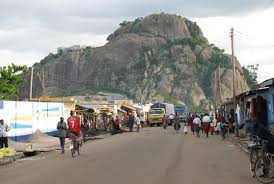The World Bank on Thursday launched a road inspection report of the North Eastern Road Corridor which calls for improvement of safety measures to make the road safer for all users. The 340km stretch, known as the North Eastern Road Corridor Asset Management Project (NERAMP) covers the Tororo-Mbale-Soroti-Lira-Kamdini road, and is about to undergo rehabilitation and improvements funded by the World Bank.
The report, funded by the Bank’s Global Road Safety Facility, was disseminated to stakeholders at a workshop held at Hotel Africana. It identified several challenges including rapid urbanization along the corridor, poor road design that is inconsistent with the geographical terrain, ineffective and limited speed control measures as well as steep embankments and slopes. A total of 98 accident blackspots were identified in the corridor – equivalent to one blackspot every 3.5km.
“Uganda has made important strides in the past decade to reduce communicable diseases, maternal deaths, and improve the overall life expectancy. Therefore, a concerted action on road safety would bring additional far-reaching benefits for the public health sector, and economic development,“ said Tony Thompson, Country Manager, World Bank.
A World Bank assessment of 135 countries, shows reducing road traffic deaths by 10 percent raises per capita real GDP by 3.6 percent over 24 years. The study, The High Toll of Traffic Injuries: Unacceptable and Preventable, finds that countries that do not invest in road safety lose anywhere between 7 and 22% in potential per capita GDP growth over the same period, which underlines the importance of investing in road safety.

“There is need for UNRA to develop a proper accident data collection and storage mechanism as part of safety appraisal of the designs and maintenance. This can be done internally with Uganda Traffic Police,” said Dr. Godfrey Mwesige, a road safety specialist who carried out the NERAMP road safety inspection.
The report is expected to inform a much safer and detailed engineering design of the NERAMP as well as to enhance road safety management capacity in the project corridor. Proposed safety measures include, changing the design of the road to make it more consistent to the terrain, improving the cross section from two-lanes to four-lanes with guardrails in the towns of Tororo, Mbale, Soroti and Lira and at the Manafwa steep descend, use of speed guns, installation of speed humps, and delineation of horizontal curves to enhance safety for night-time driving with chevron signs.
The Minister of State for Transport, Aggrey Henry Bagiire welcomed the World Bank’s support to the transport sector, a priority for government to drive growth and prosperity but noted the importance of ensuring that the designs and safety measures are forward-looking and cater to the rising population and urbanization trends. “The designs need to change to reflect the changing circumstances. If roads are safe by design, it is possible to reduce road accident deaths by as much as 30 percent,” the minister said.
The Traffic and Road Safety department of the Uganda National Roads Authority (UNRA) will play a leading role in implementing the safety interventions in the project corridor, including raising public awareness and supporting traffic authorities in enforcement.
“The Unit will be coordinating and liaising with all key stakeholders, including the police, the contractor, and the National Road Safety Council. The Unit will follow up on the NERAMP road safety performance and compliance to requirements of the national road safety standards and programs,” said Allen Kagina, Executive Director, Uganda National Roads Authority (UNRA). “UNRA will strive to continually engage all these partners and to recognise the unique role each of them has to play”.
Two other road safety audit surveys will be carried out during the project life cycle to inform further safety measures and assess the quality of implementation. The NERAMP project is the first of its kind in Uganda to apply the cost-effective Output and Performance Based Road Contract (OPRC) – where payments for management and maintenance of road infrastructure is linked to the contractor successfully meeting or exceeding defined minimum performance indicators.
The project’s development objective is to reduce transport costs, enhance road safety and improve and preserve the road assets sustainably along the north eastern road corridor. The road safety audit is part of a multi-faceted Legislative Action Plan aimed at addressing road safety issues in Uganda, in partnership with Safe Way Right Way, financed by the Global Road Safety Facility (GRSF).
The GRSF is a global partnership program administered by the World Bank with the mission to help address the growing crisis of road carnage in low and middle-income countries. The facility provides funding, knowledge, and technical assistance designed to scale-up the efforts of low- and middle-income countries to build their scientific, technological and managerial capacities.





